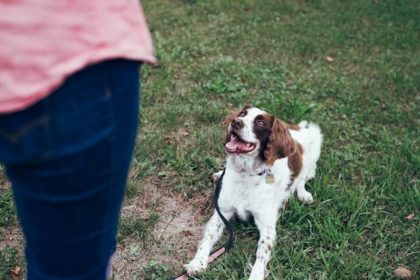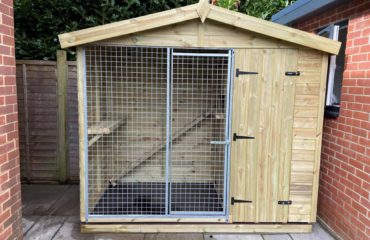The Importance of Kennel Training for Dogs: A Comprehensive Overview

Getting your dog acclimated to their new kennel is important for your pet’s overall well-being. With successful kennel training, you can ensure that your dog stays safe, healthy, and happy when they’re left alone in their kennels. However, kennel training can be challenging, as it requires time, patience, and the right training techniques.
Without proper training, your dog may deal with anxiety issues or view spending time in the kennel as a negative experience. To successfully kennel train your dog, you’ll want to employ clear commands and use positive reinforcement. We’ll dive deeper into the best practices of kennel training so you can start training your dog to love spending time in their kennel. We’ll also talk about selecting an appropriate kennel, like one from Benchmark Kennels.
Why Is Kennel Training Important?
If you’ve never used a kennel before, you may wonder about the benefits of kennel training. There are several significant benefits you should consider. Whether you’re looking to train a puppy or an older dog, the kennel can be a safe space for your dog to relax and play by themself for periods of time.
Outdoor dog kennels are great for dogs who have to spend time away from their owners. It allows them to be outdoors in the fresh air while remaining safe and secure despite being unsupervised. Though dogs should not be kept in outdoor dog kennels for an extended period of time, they can be useful when you plan to be away from home for a couple of hours.
One of the most significant benefits of using outdoor dog kennels is the safety and security they provide. With a fully enclosed structure, you won’t have to worry about your pet jumping over a fence and escaping. This type of enclosure also provides safety benefits for your pet by keeping out other animals that are potentially aggressive toward your dog.
Dog kennels are also great for pets who thrive outdoors. Some dogs prefer spending time outdoors versus indoors. The kennel provides enough outdoor space for your pet to move around and play. But the indoor area provides shelter as needed.
Dog kennels are also a good option for dogs who have destructive habits. Keeping your dog in a kennel may also prevent them from ingesting something they shouldn’t while you’re away from the home. Plus, if you want to avoid coming home to a mess and destroyed items, a kennel may be the right solution.
How Do You Successfully Kennel Train Your Dog?
With so many benefits to outdoor kennels, you’ll likely want to try out this solution for your dog. However, some dogs may be fearful of the kennel or have separation anxiety. Depending on your dog’s temperament and history, kennel training might happen quickly or it could take a long time. It’s important to remain patient during the training process, as you want your dog to stay calm and relaxed during their time in the kennel.
Start Slowly Introducing Your Dog to the Kennel
One of the most important techniques of kennel training is to take things slowly. You should never push your dog to spend time in the kennel when they’re scared or unwilling. For the first step of training, you should introduce your dog to the kennel. Since this is the beginning of the training, you don’t want to try too much too fast.
Let your dog wander and explore the area while offering plenty of verbal praise. If your dog doesn’t want to enter the space, you could try leaving treats inside. All of this positive praise and food will help your dog to view the kennel as a positive experience.
The next time you let your dog interact with the kennel, you might try closing the door. Once they’ve finished exploring or eating their treats, you can let them back out. Keep increasing the time your dog spends in the kennel slowly. Eventually, you’ll be able to leave them alone for short periods of time.
Use Positive Association Techniques
Another tactic you should use when kennel training your pup is to use positive association techniques. The right kind of positive reinforcement will depend on the dog. If your dog loves to play, then you’ll want to place their favourite toys in the kennel. Encourage your dog to play and get comfortable in the kennel by using verbal praise. Some of the best toys to include in the space are ropes, chew toys, and treat puzzle games. These items will help to hold your dog’s attention, which may help to lessen any anxiety or boredom while in the kennel.
You might also consider using food as a positive reinforcement. For many dogs, offering special treats in the kennel will help them to associate the space with positive experiences. Having your dog regularly eat their meals in the kennel can also be helpful during the training process.
Use the Right Commands
During training, you’ll want to teach your dog new commands related to the kennel. You can teach them new commands related to their kennel by using treats and praise. By teaching commands, your dog will know when to go to the kennel. You can choose whatever verbal cues you would like. Simply saying “kennel” is an effective command.
With this verbal cue, your dog will know to enter the kennel. Having this command is helpful as you’ll easily be able to put your dog in the kennel when you’re in a rush. If your dog doesn’t understand this command, getting them to enter the kennel could be challenging and frustrating.
To begin teaching your dog a command for using their kennel, say the verbal cue as they enter the space. Then either use a clicker or say the word “yes.” Hand them a treat for this behaviour, and continue to repeat this process over again. It’s a good idea to practice this verbal cue about ten times per session. You’ll want to repeat this training game daily for a few days.
After several days, you should try to repeat the training game without the treats. Simply, say the command and give verbal praise when they’ve entered the kennel. You may want to include a hand gesture with the command, as it will provide another cue for your dog. After practising training without treats several times, your dog should understand the command going forward.
What Should You Avoid Doing When Kennel Training?
There are several things you should avoid doing when kennel training. By avoiding them, you’ll keep your dog’s kennel training on track. One of the most important things you should avoid doing when kennel training your dog is to avoid using the kennel as a punishment. It’s important to only use positive association techniques with the kennel. If you start to use the kennel as a punishment, your dog won’t feel comfortable in the space. This can make it harder for you to train them.
Another important thing to avoid doing with kennel training is to leave your dog for long periods of time. Even if they start to enjoy spending time in the kennel, you should never confine your dog to this space for extended periods. Dogs need proper exercise and socialization. They’ll also want to sniff and take bathroom breaks away from their kennel. If you plan to leave your house for a full day, you’ll want to hire a dog walker to break up the time spent in the kennel.
You’ll also want to keep all initial time spent in the kennel short, as you want your dog to acclimate to the kennel at their own pace. You should never force your dog into the kennel or leave them alone before they’re ready. Though this technique might seem slow, it ultimately will lead to better success than trying to speed through the training.
How Long Does Kennel Training Take?
The amount of time it takes to kennel train your dog varies depending on a few different factors. As with any kind of dog training, each animal learns at their own pace. So, while some dogs may quickly pick up the verbal cues and acclimate to the kennel quickly, other dogs may need more time.
The length of training also depends on your dog’s age, history, and temperament. For example, it may be hard to train a dog that’s a rescue. You don’t know their background or history, so they may have more complex behavioural issues than you know about. Additionally, older dogs may be more resistant to learning new training. Finally, some pets may not be well suited for outdoor dog kennels due to their temperament. Whether they’re dealing with separation anxiety or they just don’t like to be enclosed, some dogs may be harder to train than others.
How Do You Choose the Right Kennel for Your Dog?
Choosing the right kennel for your dog plays a big role in how well they adapt to their new environment. When you go to pick out a new kennel, you’ll want to choose one that is large enough for your dog to be comfortable. For your dog to be comfortable, you’ll want a kennel where your dog can lie down, stretch, and turn around.
On the outside runner attached to the kennel, you’ll want to ensure that your dog has enough space to play and stay active. Depending on the dog’s breed and temperament, you may want to choose a kennel with a larger runner, as active dogs will enjoy more outside space. They should have enough room to stand on their hind legs and walk about a little. With smaller breeds, the structure of the kennel will likely be small. However, with larger breeds, you’ll need to invest in a big kennel.
Another aspect to consider when choosing the right kennel is the quality of materials. You should aim to pick a kennel that’s made out of durable and long-lasting materials. By choosing a kennel made of high-quality and sturdy materials, you’ll have more peace of mind knowing your dog is safely contained. Especially for dogs with destructive habits, pet owners will want to consider kennels that are resistant to chewing.
Our Commitment to Quality Kennels
If you’re looking for high-quality dog kennels that are made out of durable materials, you should consider one of our options. We offer wooden or eco-thermal kennel options. Additionally, our kennels are available in a range of sizes so you’ll be able to find a kennel that’s large enough to comfortably accommodate your dog.
If you have a small breed, such as a chihuahua, you’ll want to look at one of our smaller options. This 6 X 3 feet kennel is perfect for small breeds. However, for bigger breeds, you’ll want to consider an option that’s large enough. This 14 X 8 feet kennel is best suited for large dogs. If you’re looking to kennel train multiple dogs, you should consider one of the double kennels or multi-bay kennels.
Kennel training provides a lot of benefits, but it may seem challenging at first. It’s important to stick with the training and provide positive associations with the kennel. This way, you’ll ensure that your dog comes to feel safe and at home inside the kennel. If you’re looking to find a kennel that will be comfortable for your dog, check out our full selection of kennel options that come with a professional fitting.




